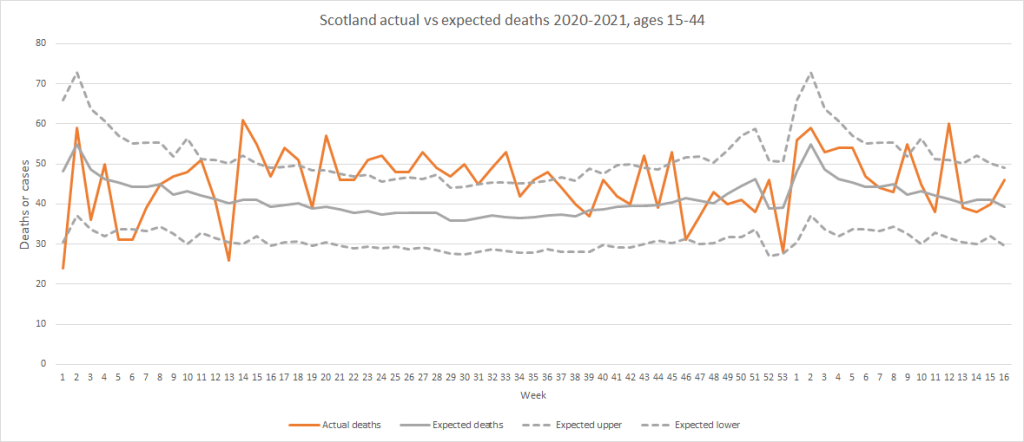A study published in the BMJ found that, among 18-65 year olds in Denmark and Norway who’d had the AstraZeneca vaccine (mostly healthcare workers), the rate of “excess” thromboembolic events (blood clots), i.e. ones that wouldn’t have been expected to happen anyway, was 11 per 100,000 people. This is an order of magnitude higher than the official rate that Public Health England is giving, probably because the population who have had the vaccine in the UK have generally been older, so there have been fewer cases (so far). The rate seems to be higher in women and in younger ages. The concern is that it’s causing an unusual type of clotting condition (VITT) that is much more likely to be fatal than a typical leg clot.
For a woman in her early forties, then, who is currently at the top of the queue for vaccination but is being prevented from accessing any other vaccine than AZ by her country’s vaccination policy, is it worth the risk? It’s difficult to assess. I don’t know when or if I might be able to get a (seemingly safer) mRNA vaccine. And I don’t know what my risk of exposure to coronavirus in the meantime will be.
One thing I have tried to quantify by way of comparison is the risks that I have lived with over the pandemic so far. I’ve updated my excess deaths analysis and looked at the 15-44 age group (I can’t break it down further). There were 280 excess deaths (0.13 months’ worth) over the whole of 2020 and first 16 weeks of 2021, and strangely, a lot of them seemed to occur over last summer when there were no covid-related deaths being recorded. So maybe just a random fluctuation. There were 13.6 excess deaths per 100,000 population in that age group in Scotland over the pandemic so far. The “covid confirmed” deaths in females aged 25-44 works out at about 3.5 per 100,000 population, so that’s probably a better sense of the risk.

On the specific issue of blood clots, a very recent study has looked at rates of occurrence of blood clots in covid cases. I took their numbers and applied to Scotland’s total covid case count (roughly inflated to account for lack of testing in the first wave*). I make it that about 134 cases of blood clots (CVT or PVT) would have occurred in Scotland to date in people with covid, which is 0.0025% of the population. (I don’t know if age is a risk factor.) This represents all instances in people with covid, not the excess risk. Even so it is not as high as the 0.011% excess risk of a blood clot in 18-65s from the AZ vaccine. However there could be other types of blood clot caused by covid besides CVT and PVT that are not included in the 0.0025% but are included in the 0.011%. I don’t know.
Finally, I used data from the ONS long covid survey to look at the risk of having symptoms that limit your activity a lot and that have gone on for more than 12 weeks. That’s a scary covid outcome. In the 35-49 age range, about 0.25% of that population seemed to be affected as at 6 March 2021. That number will not include cases from the January surge as that would have been less than 12 weeks prior to the survey. It also wouldn’t include anyone who had it earlier and recovered before the survey. But it will certainly capture a lot of cases from the autumn wave.
I do worry about long covid. It’s not rare at all. About 5% of people who’d ever been ill with covid up to mid-December (again, inflating the first wave case count to compensate for lack of testing) were still ill on 6 March to an extent that limited their activities a lot. However, the median duration of symptoms is stated in the report to be 35.5 days – and that presumably won’t take into account asymptomatic infections (the Scottish Government have an ad campaign to encourage compliance with restrictions and one of the ads states “1 in 3 people don’t know they have it”. That would amount to about 140,000 undetected infections in Scotland so far).
It’s a subjective, emotional decision as all decisions are. At the moment I don’t feel convinced to take AstraZeneca. It seems reasonable to hold out for the chance of an mRNA vaccine. There is nobody especially vulnerable around me that hasn’t been vaccinated themselves. The mRNA vaccines are a better choice, and normally healthcare practice is to provide choice, so it feels inappropriately coercive to be encouraged to take AZ and offered nothing else, and to be threatened with “going to the back of the queue” for refusing. That tends to make me dig my heels in. It also doesn’t make me feel assured that they would take symptoms seriously and do everything necessary to save my life if I developed VITT.
If there really aren’t enough mRNA vaccines for everyone left who wants one, then they can order more. Those of us who aren’t in the priority groups can afford to wait. Ideally, I’d like to see people at higher risk around the world given vaccines long before the West starts vaccinating its children – which it is already doing. Excessive covid-safetyism has bothered me all through this pandemic and now it’s manifesting in both nationalist vaccine greed and pushing ahead with a vaccine that is statistically going to kill some people (while other safer vaccines exist).
Deaths of forty-something women are starting to hit the news, just like clockwork. BBC presenter Lisa Shaw, 44. It could be a grim few weeks.
*by assuming that death counts are complete throughout and case fatality ratio did not change


Pingback: How much did Covid-19 change our risk of death? | Meaning and Truth